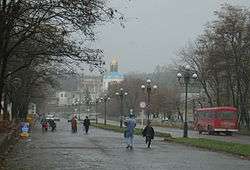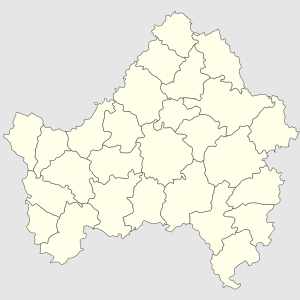Dyatkovo
| Dyatkovo (English) Дятьково (Russian) | |
|---|---|
| - Town[1] - | |
 View of Dyatkovo | |
.svg.png) Location of Bryansk Oblast in Russia | |
 Dyatkovo | |
|
| |
| Administrative status (as of November 2012) | |
| Country | Russia |
| Federal subject | Bryansk Oblast[1] |
| Administrative district | Dyatkovsky District[2] |
| Urban Administrative Okrug | Dyatkovsky[2] |
| Administrative center of | Dyatkovsky District,[1] Dyatkovsky Urban Administrative Okrug[2] |
| Municipal status (as of August 2012) | |
| Municipal district | Dyatkovsky Municipal District[3] |
| Urban settlement | Dyatkovskoye Urban Settlement[3] |
| Administrative center of | Dyatkovsky Municipal District,[3] Dyatkovskoye Urban Settlement[3] |
| Statistics | |
| Population (2010 Census) | 29,439 inhabitants[4] |
| Time zone | MSK (UTC+03:00)[5] |
| First mentioned | 1626 |
| Town status since | 1938 |
| Postal code(s)[6] | 242600—242604 |
| Dialing code(s) | +7 48333 |
|
| |
| Dyatkovo on Wikimedia Commons | |
Dyatkovo (Russian: Дя́тьково) is a town and the administrative center of Dyatkovsky District in Bryansk Oblast, Russia. Population: 29,439 (2010 Census);[4] 33,600 (2002 Census);[7] 34,413 (1989 Census).[8]
History
It was first mentioned in 1626, but its development was not boosted until 1785, when after the death of Akim Vasilyevich Maltsov, his widow, Marya, bought out a factory from Yevdokiya, the widow of Alexander Vasilyevich Maltsov, and decided to expand its production. In 1790, in a forest near Dyatkovo, Marya Maltsova built the now famous glass and crystal factory, the quality of products of which was comparable to that of the plant in Gus. The workers' settlement around the plant soon grew in size and absorbed the village of Dyatkovo.
In 1798, the ownership of the company passed to Ivan Akimovich Maltsov, who created an entire industrial empire centered in Dyatkovo. In 1853, his business was continued by his son Sergey. By then, 100,000 people were employed by Maltsov's factories, which had their own currency, police force, and a 202-verst (215 km; 134 mi) long railway.
In 1918, when all of the Maltsov's factories were nationalized, the "State Maltsov Factory District" trust centered in Dyatkovo was established. In 1929, Dyatkovsky District produced about 10% of all the window glass produced in the Soviet Union.
Town status was granted to Dyatkovo in 1938.
Bryansk Oblast was a center of partisan movement during World War II. The German Army occupied Dyatkovo on 9 October 1941. In February 1942, Soviet partisans managed to retake power in Dyatkovo and neighboring villages. The area was deeply inside Nazi-occupied territory. The partisans ran a hospital and various shops but were overrun by the Nazis in June 1942. The Red Army retook Dyatkovo on 15 September 1943.
Administrative and municipal status
Within the framework of administrative divisions, Dyatkovo serves as the administrative center of Dyatkovsky District.[1] As an administrative division, it is, together with five rural localities, incorporated within Dyatkovsky District as Dyatkovsky Urban Administrative Okrug.[2] As a municipal division, Dyatkovsky Urban Administrative Okrug is incorporated within Dyatkovsky Municipal District as Dyatkovskoye Urban Settlement.[3]
Economy and culture
Dyatkovo is most noted for its lead crystal factory, furniture factory, and the Lead Crystal Museum, the largest museum of artistic glass in the country.
Religion
The Dyatkovo Transfiguration Church was opened in 1810. Its paintings were done in the Italian style and the iconostasis was made of crystal, as was the church's enormous chandelier. After the demolition of the church in 1929, the crystal iconostasis was lost. In 2003, new Dyatkovo church was built in honor of icon "Neopalimaya Kupina" ("Burning Bush"). The church possesses the world's only crystal iconostasis, which was made by the Dyatkovo Crystal Factory and which weighs about three tons.
References
Notes
- 1 2 3 4 Law #13-Z
- 1 2 3 4 Law #69-Z
- 1 2 3 4 5 Law #3-Z
- 1 2 Russian Federal State Statistics Service (2011). "Всероссийская перепись населения 2010 года. Том 1" [2010 All-Russian Population Census, vol. 1]. Всероссийская перепись населения 2010 года (2010 All-Russia Population Census) (in Russian). Federal State Statistics Service. Retrieved June 29, 2012.
- ↑ Правительство Российской Федерации. Федеральный закон №107-ФЗ от 3 июня 2011 г. «Об исчислении времени», в ред. Федерального закона №271-ФЗ от 03 июля 2016 г. «О внесении изменений в Федеральный закон "Об исчислении времени"». Вступил в силу по истечении шестидесяти дней после дня официального опубликования (6 августа 2011 г.). Опубликован: "Российская газета", №120, 6 июня 2011 г. (Government of the Russian Federation. Federal Law #107-FZ of June 31, 2011 On Calculating Time, as amended by the Federal Law #271-FZ of July 03, 2016 On Amending Federal Law "On Calculating Time". Effective as of after sixty days following the day of the official publication.).
- ↑ Почта России. Информационно-вычислительный центр ОАСУ РПО. (Russian Post). Поиск объектов почтовой связи (Postal Objects Search) (Russian)
- ↑ Russian Federal State Statistics Service (May 21, 2004). "Численность населения России, субъектов Российской Федерации в составе федеральных округов, районов, городских поселений, сельских населённых пунктов – районных центров и сельских населённых пунктов с населением 3 тысячи и более человек" [Population of Russia, Its Federal Districts, Federal Subjects, Districts, Urban Localities, Rural Localities—Administrative Centers, and Rural Localities with Population of Over 3,000] (XLS). Всероссийская перепись населения 2002 года [All-Russia Population Census of 2002] (in Russian). Retrieved August 9, 2014.
- ↑ Demoscope Weekly (1989). "Всесоюзная перепись населения 1989 г. Численность наличного населения союзных и автономных республик, автономных областей и округов, краёв, областей, районов, городских поселений и сёл-райцентров" [All Union Population Census of 1989: Present Population of Union and Autonomous Republics, Autonomous Oblasts and Okrugs, Krais, Oblasts, Districts, Urban Settlements, and Villages Serving as District Administrative Centers]. Всесоюзная перепись населения 1989 года [All-Union Population Census of 1989] (in Russian). Институт демографии Национального исследовательского университета: Высшая школа экономики [Institute of Demography at the National Research University: Higher School of Economics]. Retrieved August 9, 2014.
Sources
- Брянская областная Дума. Закон №13-З от 5 июня 1997 г. «Об административно-территориальном устройстве Брянской области», в ред. Закона №4-З от 5 февраля 2014 г. «О внесении изменений в отдельные законодательные акты Брянской области». Опубликован: "Брянский рабочий", №119, 24 июня 1997 г. (Bryansk Oblast Duma. Law #13-Z of June 5, 1997 On the Administrative-Territorial Structure of Bryansk Oblast, as amended by the Law #4-Z of February 5, 2014 On Amending Various Legislative Acts of Bryansk Oblast. ).
- Брянская областная Дума. Закон №69-З от 2 ноября 2012 г. «Об образовании городских административных округов, поселковых административных округов, сельских административных округов, установлении границ, наименований и административных центров административных округов в Брянской области». Вступил в силу 1 января 2013 г. Опубликован: Информационный бюллетень "Официальная Брянщина", №16, 6 ноября 2012 г.. (Bryansk Oblast Duma. Law #69-Z of November 2, 2002 On the Establishment of Urban Administrative Okrugs, Settlement Administrative Okrugs, Rural Administrative Okrugs, on Establishing Borders, Names, and Administrative Centers of the Administrative Okrugs of Bryansk Oblast. Effective as of January 1, 2013.).
- Брянская областная Дума. Закон №3-З от 9 марта 2005 г. «О наделении муниципальных образований статусом статусом городского округа, муниципального района, городского поселения, сельского поселения и установлении границ муниципальных образований в Брянской области», в ред. Закона №75-З от 28 сентября 2015 г. «Об изменении статуса населённого пункта посёлок Красный Ятвиж Клетнянского района Брянской области». Вступил в силу через 10 дней после официального опубликования. Опубликован: "Брянская неделя", №13, 8 апреля 2005 г. (Bryansk Oblast Duma. Law #3-Z of March 9, 2005 On Granting the Municipal Formations the Status of Urban Okrug, Municipal District, Urban Settlement, Rural Settlement and on Establishing the Borders of the Municipal Formations of Bryansk Oblast, as amended by the Law #75-Z of September 28, 2015 On Changing the Status of the Inhabited Locality the Settlement of Krasny Yatvizh in Kletnyansky District of Bryansk Oblast. Effective as of the day which is 10 days after the official publication.).
External links
- Official website of Dyatkovo (Russian)
- Website of the Dyatkovo Crystal Museum (English) (Russian)
- Official website of the Dyatkovo Crystal Factory (English) (Russian)